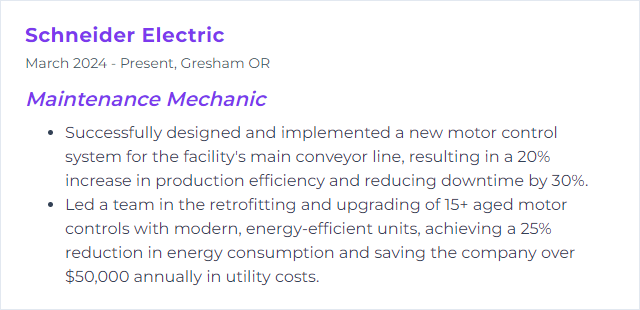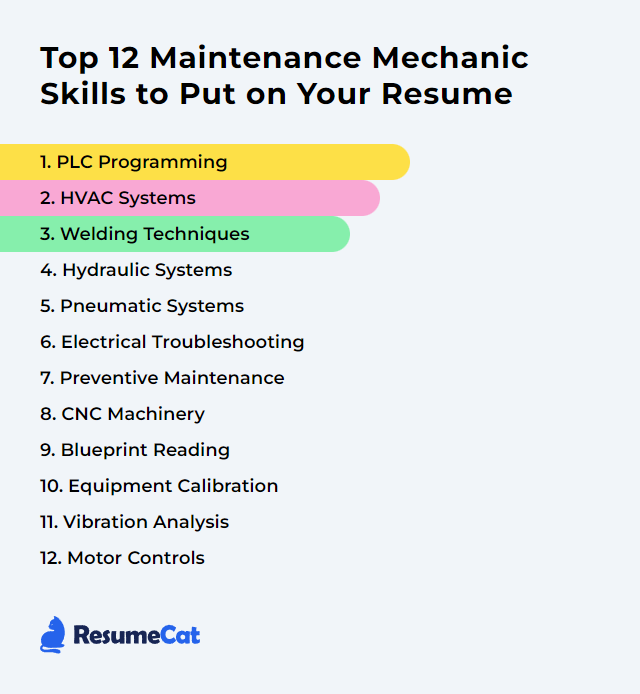Top 12 Maintenance Mechanic Skills to Put on Your Resume
In today's job market, standing out as a maintenance mechanic takes more than a toolbox and a steady hand. A sharp resume that blends technical depth, fast-on-your-feet troubleshooting, and people skills can tilt the odds your way—showing you’re versatile, reliable, and ready to keep production humming.
Maintenance Mechanic Skills
- PLC Programming
- HVAC Systems
- Welding Techniques
- Hydraulic Systems
- Pneumatic Systems
- Electrical Troubleshooting
- Preventive Maintenance
- CNC Machinery
- Blueprint Reading
- Equipment Calibration
- Vibration Analysis
- Motor Controls
1. PLC Programming
PLC programming means writing and modifying logic that directs machines and processes—automation with purpose, tuned to real-world equipment and safety constraints.
Why It's Important
It shrinks downtime, boosts consistency, and makes troubleshooting less guessy. When logic mirrors the process, you find faults faster and keep lines running.
How to Improve PLC Programming Skills
Build the foundation, then layer on real-world practice:
Master the fundamentals: I/O, scan cycles, addressing, data types, interlocks, and safe states.
Ladder first, then more: Get fluent in Ladder Logic, then explore Function Block, Structured Text, and Sequential Function Charts where they fit.
Use vendor-grade tools: Practice with simulators and common platforms (for example, Studio 5000 for Logix controllers, TIA Portal for Siemens). Sim first, hardware second.
Mimic real processes: Build small projects—conveyors, pump skids, batching sequences—and document cause/effect matrices.
Troubleshoot methodically: Force inputs in a safe environment, trend tags, validate permissives, and keep change logs.
Keep learning: Take manufacturer training, pursue certifications, and study existing plant code to see proven patterns.
How to Display PLC Programming Skills on Your Resume
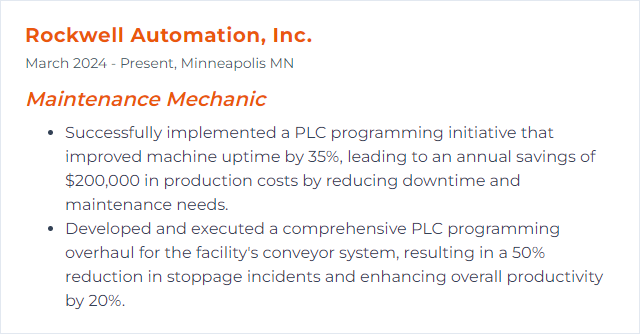
2. HVAC Systems
HVAC—heating, ventilation, air conditioning—manages temperature, humidity, and air quality. Mechanics inspect, tune, and repair components so comfort and efficiency don’t drift.
Why It's Important
Comfort, air quality, and equipment longevity ride on HVAC performance. Efficient systems cut energy costs and prevent ugly surprises in peak seasons.
How to Improve HVAC Systems Skills
Stick to a cadence: Filters, coils, drains, belts, bearings. Clean, tighten, replace. Routine beats reactive.
Seal and insulate: Tight ducts and proper insulation slash losses and keep supply air honest.
Smart controls: Program thermostats and schedules, verify setbacks, calibrate sensors, and validate economizer operation.
Tune refrigeration circuits: Weigh in charge where required, confirm superheat/subcooling, and check for non-condensables.
Focus on air: Balance airflow, clear obstructions, maintain proper ventilation rates, and monitor IAQ.
Upgrade with intent: High-efficiency equipment and variable-speed drives can pay back through quieter operation, fewer starts, and lower bills.
How to Display HVAC Systems Skills on Your Resume

3. Welding Techniques
Welding joins metals with heat, pressure, or both. Common processes:
- Shielded Metal Arc (SMAW): Versatile, rugged, field-friendly.
- Gas Metal Arc (GMAW/MIG): Fast deposition and easy to learn.
- Gas Tungsten Arc (GTAW/TIG): Precision, clean beads, tight control.
- Oxy-fuel: Handy for brazing, cutting, and some repair work.
Each demands specific prep, joint design, and PPE—plus attention to metallurgy and heat-affected zones.
Why It's Important
Strong, clean welds restore integrity and keep machinery in service. Done right, you reduce rework and downtime, full stop.
How to Improve Welding Techniques Skills
Start with fundamentals: Joint prep, fit-up, polarity, gas flow, amperage/voltage, and travel speed.
Practice with purpose: Vary positions, materials, and thicknesses. Track settings and results. Iterate.
Mind the metallurgy: Know base metals, filler compatibility, preheat/postheat, and distortion control.
Prioritize safety: Ventilation, fire watch, PPE, and adherence to current safety guidance.
Seek critique: Have experienced welders evaluate bead appearance, penetration, and defects.
Certify and refresh: Formal training and certifications validate skill and broaden opportunities.
How to Display Welding Techniques Skills on Your Resume
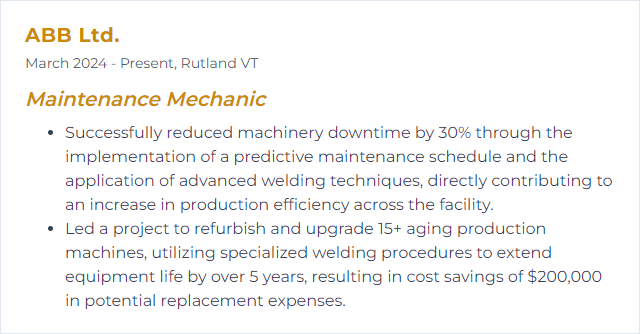
4. Hydraulic Systems
Hydraulics transmit power through pressurized fluid—muscle for lifts, clamps, drives, and smooth control.
Why It's Important
High force, fine control, repeatable motion. Keep it clean and tight, and hydraulic equipment works like a trusty lever with a modern brain.
How to Improve Hydraulic Systems Skills
Cleanliness first: Use the right fluid, keep it clean and dry, and change filters on condition or schedule.
Inspect routinely: Hoses, fittings, seals, cylinders, pumps. Look for leaks, abrasion, and temperature hotspots.
Monitor health: Track pressure, flow, temperature, and particle counts. Trend data to catch drift early.
Verify settings: Relief pressures, load-sense lines, valve spool function—document and lock in baselines.
Upgrade wisely: Modern components can cut energy use and heat, improving reliability.
Train continuously: New valve technologies and fluids change best practices. Stay current.
How to Display Hydraulic Systems Skills on Your Resume

5. Pneumatic Systems
Pneumatics use compressed air for motion, clamping, and control. Clean, quick, and forgiving when maintained well.
Why It's Important
They’re straightforward, safe in many environments, and excellent for rapid, repetitive motion. Easy to troubleshoot, too—if leaks don’t drain your efforts.
How to Improve Pneumatic Systems Skills
Chase leaks relentlessly: Even small leaks erode pressure and dollars. Detect, tag, fix, verify.
Protect air quality: Dryers, filters, and proper lubrication keep valves and actuators happy.
Right-size components: Oversized lines and under-sized valves both cause headaches. Match Cv and flow to the job.
Maintain compressors: Service intakes, belts, coolers, drains, and controls. Check storage and distribution for pressure drop.
Document settings: Regulator setpoints, cycle times, and valve functions—baseline and audit them.
How to Display Pneumatic Systems Skills on Your Resume
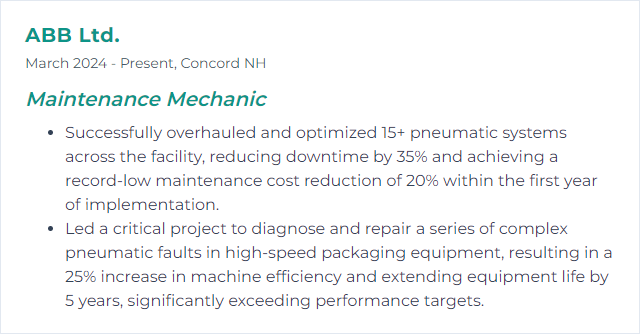
6. Electrical Troubleshooting
Systematically finding and fixing faults in electrical circuits and controls—without creating new ones in the process.
Why It's Important
Fast, safe diagnosis prevents cascading failures, keeps teams safe, and restores production with minimal drama.
How to Improve Electrical Troubleshooting Skills
Own the basics: Ohm’s Law, AC/DC behavior, protection devices, and power distribution.
Read the map: Schematics, wiring diagrams, terminal designations, and PLC I/O maps. Trace signals end to end.
Use the right instruments: Multimeters, clamp meters, insulation testers, and safe test procedures.
Start simple: Verify power, grounds, fuses, and connectors before chasing ghosts.
Segment the system: Divide and conquer—narrow the fault domain, swap known-good components when appropriate, and confirm with measurements.
Practice safety: Lockout/tagout, arc-flash PPE, proper test leads, and live-dead-live checks.
Keep sharpening: Training, practice panels, and knowledge sharing with peers build speed and accuracy.
How to Display Electrical Troubleshooting Skills on Your Resume
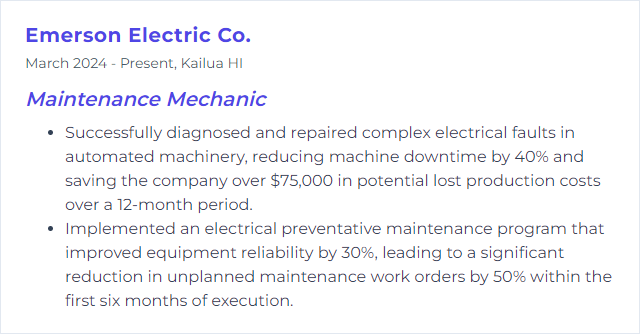
7. Preventive Maintenance
Scheduled inspections and service to stop failures before they start. Lubrication, adjustments, calibrations, and timely part replacements—done on purpose, not by panic.
Why It's Important
It reduces surprises, extends asset life, trims costs, and keeps uptime steady. The quiet hero of reliable operations.
How to Improve Preventive Maintenance Skills
Plan and prioritize: Build PMs from OEM guidance, failure modes, and history. Group tasks by access and downtime windows.
Use condition data: Add vibration, thermography, oil analysis, and runtime metrics to target work where risk is rising.
Leverage a CMMS: Schedule, track, and analyze. Close the loop with failure codes and root-cause notes.
Standardize procedures: Clear work instructions, torque specs, and acceptance criteria reduce variation.
Stock smart: Critical spares on hand, reorder points set from lead times and consumption, and vendor agreements ready.
Continuously improve: Review PM effectiveness, trim non-value tasks, and adjust frequencies based on data.
How to Display Preventive Maintenance Skills on Your Resume

8. CNC Machinery
CNC machines interpret code to cut, mill, turn, and shape with precision. Mechanics keep motion smooth, spindles healthy, and errors scarce.
Why It's Important
Precision and repeatability depend on tight mechanics and clean control. When CNCs drift, scrap piles grow.
How to Improve CNC Machinery Skills
Follow disciplined maintenance: Cleanways, lubrication, way covers, coolant quality, chip evacuation, and spindle warm-up routines.
Stay current on software: Keep controls and CAM posts updated. Back up parameters and verify after updates.
Verify geometry: Ballbar tests, laser calibration, alignment checks, and toolholder inspection to keep tolerances honest.
Train on controls: Learn common platforms and alarms. Faster diagnosis, safer recovery.
Add predictive signals: Monitor spindle vibration, temperature, and load to flag issues before bearing failure knocks production out.
How to Display CNC Machinery Skills on Your Resume

9. Blueprint Reading
Interpreting drawings, symbols, tolerances, and notes to understand how parts fit, move, and function—so repairs match design intent.
Why It's Important
Accurate reads prevent wrong parts, botched fits, and risky assumptions. You see the machine on paper before you touch a wrench.
How to Improve Blueprint Reading Skills
Learn the language: GD&T, line types, surface finishes, weld symbols, and revision control.
Practice 2D to 3D: Convert orthographic and isometric views in your head. Sketch assemblies to cement understanding.
Focus on function: Tie features to purpose—fits, clearances, datum schemes—and anticipate failure modes.
Study assemblies: Exploded views, BOMs, fastener specs, and torque notes. Trace how parts stack and move.
Get feedback: Review interpretations with experienced machinists or engineers to tighten accuracy.
How to Display Blueprint Reading Skills on Your Resume

10. Equipment Calibration
Adjusting instruments and machines to known standards so measurements stay trustworthy and processes stay in spec.
Why It's Important
Bad readings drive bad decisions. Proper calibration cuts scrap, reduces rework, and supports compliance.
How to Improve Equipment Calibration Skills
Set a schedule: Base intervals on risk, usage, and history—not guesswork.
Use traceable standards: Reference equipment should be traceable to recognized national or international standards.
Control conditions: Stabilize temperature, humidity, and vibration during calibration to reduce drift.
Document everything: As-found/as-left data, tolerances, serials, and technician sign-off.
Inspect first: Damage, wear, contamination, and loose connections can skew results before you even start.
Outsource when needed: Complex or critical instruments merit accredited service providers.
How to Display Equipment Calibration Skills on Your Resume
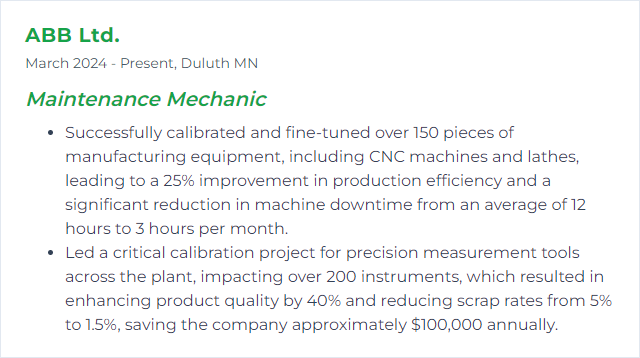
11. Vibration Analysis
Reading vibration signatures to spot imbalance, misalignment, looseness, or bearing wear—long before failure shows up as smoke and noise.
Why It's Important
It turns guesswork into foresight, letting you plan repairs, avoid secondary damage, and protect production schedules.
How to Improve Vibration Analysis Skills
Learn the patterns: Frequency fundamentals, harmonics, sidebands, and bearing fault signatures.
Use quality instruments: Reliable sensors and analysis software matter. Calibrate and verify mounting methods.
Collect consistent data: Same points, same load, same speeds. Trend over time to separate noise from signal.
Correlate with reality: Compare spectra with machine design, maintenance history, and operating conditions.
Keep training: Formal courses and certification programs sharpen interpretation skills.
How to Display Vibration Analysis Skills on Your Resume

12. Motor Controls
Hardware and logic that start, stop, protect, and modulate motors—across contactors, overloads, VFDs, soft starters, and PLC interfaces.
Why It's Important
Proper control reduces stress on equipment, trims energy use, and keeps safety interlocks honest. When controls are robust, downtime shrinks.
How to Improve Motor Controls Skills
Maintain rigorously: Tighten terminations, test overloads, inspect contact wear, and verify grounding and bonding.
Adopt VFDs where sensible: Variable speed brings process control and energy savings—set ramp rates, torque limits, and protections correctly.
Use soft starters strategically: Reduce inrush and mechanical shock on high-inertia loads.
Standardize MCCs and documentation: Clear labeling, updated schematics, and spare drawer organization speed repairs.
Monitor continuously: Temperature, current imbalance, insulation resistance, and bearing condition feed predictive maintenance.
Train on safety: Arc flash studies, coordination, and proper PPE save lives and equipment.
How to Display Motor Controls Skills on Your Resume
